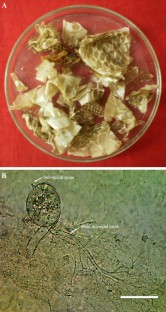First report on Obelidium megarhizum (Chytridiaceae) from India
Short Communications | Published: 05 November, 2019
First Page: 643
Last Page: 646
Views: 3715
Keywords: Chytridiomycetes, Obelidium , Purified snake skin, Keratinophilic, Chandra Prabha Wildlife Sanctuary
Abstract
In the present report, Obelidium megarhizum Willoughby was isolated, described and illustrated based on morphological traits. The species is mainly recognized by the presence of conspicuous sub-apical spine or barb bearing thin-walled sporangium and relatively coarse rhizoidal system. Short description, comments, color photo, and illustration, accompanied by its comparison with other allied taxa of the genus are provided in this paper for this relatively rare species. To the best of our knowledge, this is the first generic record of O. megarhizum outside UK, USA, and Poland.

References
- Blackwell WH, Letcher PM, Powell MJ (2012) Synopsis of Obelidium (Chytridiomycota). Phytologia 94(1):103–117
- Czeczuga B, Godlewska A (1998) Chitinophilic zoosporic fungi in various types of water bodies. Acta Mycol 33(1):43–58
- Dayal R (1997) Chytrids of India. MD Publications Pvt Ltd, New Delhi
- Dubey MK, Upadhyay RS (2013) Isolation and characterization of some Indian Hyphochytriomycetes. Int Res J Biol Sci 2:31–34
- Dubey MK, Zehra A, Meena M, Upadhyay RS (2016) Taxonomic notes on Allomyces neomoniliformis (Blastocladiaceae) isolated from Nainital lake, Uttarakhand, India. Vegetos 29(2):1–7
- Dubey MK, Zehra A, Meena M, Upadhyay RS (2018) Taxonomic note on a rare fish infecting Indian water mould Achlya ambisexualis (Achlyaceae). Indian J Fish 65(1):71–78
- Dubey MK, James TY, Zehra A, Aamir M, Upadhyay RS (2019) First record of Newbya recurva (Saprolegniaceae) from India. Nova Hedwigia. https://doi.org/10.1127/nova_hedwigia/2019/0537
- Fuller MS, Jaworski A (1987) Zoosporic fungi in teaching and research. Southeastern Pub Co, Athens
- James TY, Porter D, Leander CA, Vilgalys R, Longcore JE (2000) Molecular phylogenetics of the Chytridiomycota supports the utility of ultrastructural data in chytrid systematic. Can J Bot 78:336–350
- Karling JS (1967) Some zoosporic fungi of New Zealand. V. Asterophlyctis, Obelidium, Rhizoclosmatium, Siphonaria and Rhizophlyctis. Sydowia 20:96–107
- Karling JS (1977) Chytridiomycetarum iconographia. Lubrecht & Cramer, Monticello, p 108
- Letcher PM, Powell MJ, Chambers JG, Longcore JE, Churchill PF, Harris PM (2005) Ultrastructural and molecular delineation of the Chytridiaceae (Chytridiales). Can J Bot 83:1561–1573
- Nowakowski L (1876) Beitrag zur Kenntniss der Chytridiaceen. Cohn Beitr Biol Pflanzen 2:73–100
- Sparrow FK (1938) The morphology and development of Obelidium mucronatum. Mycologia 30:1–14
- Sparrow FK (1960) Aquatic phycomycetes, 2nd revised edition. University of Michigan Press, Ann Arbor
- Willoughby LG (1961) Chitinophilic chytrids from lake muds. Trans Br Mycol Soc 44:586–592
Author Information
Laboratory of Mycopathology and Microbial Technology, Centre of Advanced Study in Botany, Institute of Science, Banaras Hindu University, Varanasi, India